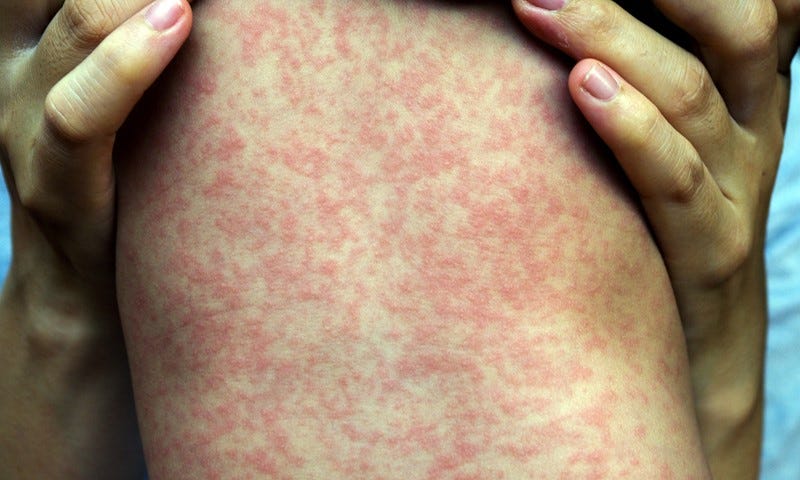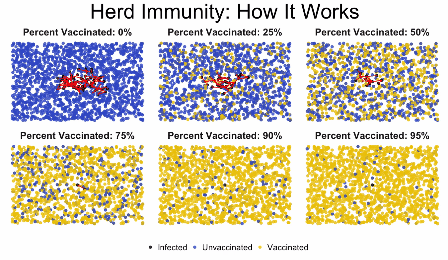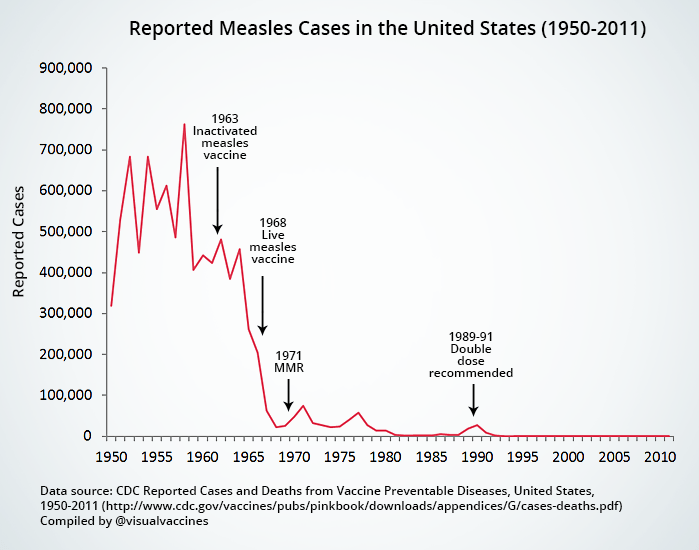Measles is not a harmless illness — complications include brain damage, immune amnesia, and death
Vaccine disinformation & wellness profiteering is driving preventable outbreaks of this deadly disease.
This newsletter is free, but it’s able to sustain itself from support I receive from a small percentage of regular readers. If you value science-based information, consider upgrading to a paid subscription:
I feel like I have déjà vu, don’t you?
Over a year ago, my first official ImmunoLogic newsletter was about measles. Measles, a vaccine-preventable infectious disease, was declared eliminated as an endemic illness in the US in 2000. And yet, 62 years after the first measles vaccine was approved by the FDA, we are still dealing with entirely avoidable outbreaks of this incredibly contagious illness.
The current outbreak in Gaines County, Texas, is the worst measles outbreak seen in the state in thirty years. In 2 weeks, 2 cases grew to 48. Today, 58 cases have now been confirmed. 13 are hospitalized, and nearly all cases are among unvaccinated individuals (or vaccination status is unknown). 83% of the cases are among children under 18.
On March 1, 2024 (I wrote yet another newsletter about measles), 15 states in the US reported 35 total cases for the year. We have already exceeded that with this one outbreak — and that’s not the only measles activity in the US: there are cases in 6 states: Texas, New Mexico, Alaska, New York, Rhode Island, and Georgia.
Note: the current numbers are likely an underestimate since the Trump administration has gutted disease surveillance and muzzled public health communications at the national level.
Low vaccination rates allows measles to spread rapidly among the population.
The statistics are shocking. We are seeing expansion of measles cases globally like not seen since before we had measles vaccines—over sixty years ago.
In 2023, there was a 20% increase in measles cases compared to 2022. In 2022, there was an 18% increase in measles cases compared to 2021. In 2023, there were significant outbreaks in 57 countries, compared to 37 countries in 2022, and 22 countries in 2021. There were over 107,000 deaths due to measles in 2023.
This trend cannot continue. People, primarily children, are dying of entirely preventable disease.
There has been global alarm about the dramatic increase in measles illnesses and death. The Pan American Health Organization alerted alliance countries to update plans to prevent the re-establishment of endemic measles. While the United States was declared free of endemic measles in 2000, increased anti-vaccine sentiment and dropping vaccine rates jeopardizes that status.
Global childhood vaccination coverage for measles dropped to 83% in 2023, well below the 95% threshold we need to control outbreaks. The US has reported the highest level of vaccine exemptions for kindergarteners ever recorded, a continued decline from the record level in the previous year. Nearly all of these exemptions were listed as ‘non-medical’.
And now, the Trump Administration and RFK Jr’s Centers for Disease Control and Prevention is only updating national disease surveillance dashboard monthly, absolutely unacceptable when we are dealing with the most contagious viral illness to humans. Of course, this follows them firing nearly the entire Epidemic Intelligence Service team: the boots-on-the-ground disease chasers that track emerging outbreaks of disease. Collectively, layoffs at the CDC total nearly 10% of the workforce.
With a long-time anti-vaccine profiteer who has lied for over 25 years about measles vaccines now at the helm of HHS, is it any wonder that we are seeing spread of this disease we thought we had under control?
Measles is the most contagious human infectious disease
Measles (Rubeola) is one of the most contagious viral illnesses in humans, caused by infection with the measles morbillivirus (MeV). Someone infected with MeV will infect, on average, 12 to 18 susceptible people. In other words, someone with measles can infect up to 90% of susceptible individuals they come in contact with.
MeV is transmitted primarily through airborne routes: the virus is released into respiratory droplets when someone sneezes, coughs, or breathes. The smaller droplets can remain suspended and travel in the air for several hours, which contributes to the high transmissibility of MeV. Merely entering a room up to 2 hours after an infected person was there can lead to infection.
MeV first infects immune cells in the upper respiratory tract and spreads throughout the body by hitching a ride to lymphoid organs like the spleen, lymph nodes, adenoids, and tonsils. In those tissues, MeV infects lymphocytes, the B and T cells of our adaptive immune system. Infected immune cells transport virus back to epithelial cells in the respiratory tract, where the virus exits the body to infect others.
MeV has a long incubation period, an average of 12 days (range 7-14 days). Initial symptoms are fever (as high as 105F), cough, runny nose, and conjunctivitis. Koplik spots (whitish-blue spots inside the lips and cheeks) also appear. The measles rash appears 2-4 days after: a flat red rash that starts at the hairline, spreads down the face, neck, torso, and extremities. People are contagious starting about 4 days before the rash appears (often when only early symptoms present). This means people may expose others before they know they have measles, contributing to viral spread.
The measles vaccine is over 97% effective—we should not have sustained measles outbreaks in the US.
As a biomedical scientist who specializes in infectious disease and cancer immunology—and a person with basic empathy— this reality is heartbreaking.
The first measles vaccine was introduced in 1963. The current measles vaccine has one of the longest continuous use profiles and is incredibly safe and effective—between 97% and 99% effective. Today, it takes conscious effort to avoid measles vaccination. This growing refusal to vaccinate that is being legitimized by our Federal leadership is eroding public health. Worse, it is killing people, children in particular.
The current outbreak in Texas is a direct result of declining vaccination rates. Gaines County, the epicenter of this outbreak, has one of the lowest vaccination rates in the state: less than 82% of entering kindergarteners are vaccinated against measles. Unfortunately, the population-level rates are likely even lower as a result of the large proportion of home-schooled kids.
The vaccine is phenomenally effective but we need 95% of our population to be vaccinated to prevent outbreaks because of how contagious MeV is. The more contagious a pathogen is, the higher the herd immunity threshold is in order to keep the spread in check.
Without that vaccination coverage, the high level of contagiousness of MeV means the virus can spread rapidly through a population—this is exactly what we are seeing in Texas, where cases went from 2 to 48 in just 2 weeks.
It’s also what happened in American Samoa in 2019, where RFK Jr. spread anti-vaccine rhetoric and discouraged widespread vaccination during a measles outbreak, leading to dozens of deaths among children and 3% of the population infected.
Measles is not some benign childhood illness—it causes death and serious disability
Prior to the introduction of the first measles vaccine in 1963, measles caused on average 2.6 million deaths every year (global population was 3 billion in 1960, compared to 8.1 billion today).
Mortality rates range from 0.1% to up to 10% in areas with lower access to care. The current global average of measles places it around 1.1% mortality. While this may seem like a small percentage if you’re used to percentages in non-disease contexts, let me assure you, this is a significant mortality rate.
On top of that 30% of measles cases lead to serious and potentially permanent complications:
Pneumonia
Blindness
Hearing loss and deafness
Severe diarrhea and dehydration
Encephalitis (brain infection and swelling)
Encephalitis occurs in about 0.3% of measles cases, and measles-associated post-acute encephalitis has a mortality rate of about 15%. That means of the 10.3 million confirmed measles cases last year, 30,900 kids developed preventable brain swelling and over 4,600 died. If someone survives encephalitis, it can cause permanent brain damage, particularly among those whose brains are still developing.
50-70% of encephalitis cases are caused by infectious diseases, primarily viral pathogens like measles.
Measles causes another complication: Subacute Sclerosing Panencephalitis (SSPE), a fatal brain disorder that occurs after primary measles.
SSPE occurs in up to 18 of every 100,000 measles cases, with the highest risk among children under 5. It is progressive, disabling, and always 100% fatal within 1 to 3 years of diagnosis. There is no cure or treatment, and for the last 60 years, has been entirely preventable.
If you think your child getting measles is no big deal, how would you feel if sometime in the future, without warning, they developed SSPE and you had to watch them deteriorate and die over the course of a few years?
Measles also causes immune amnesia: infection damages memory immunity you’ve developed to other diseases.
Remember where I mentioned MeV likes to infect immune cells? After they hitch a ride within innate immune cells to lymphoid organs, MeV infects adaptive immune cells: B cells and T cells (lymphocytes). These are your memory immune cells. But they don’t just represent memory immunity to measles, but to any previous infections and vaccinations. For a brief primer on immune response to viral infections, read below:
When MeV infects B and T cells and replicates within them, the virus damages and destroys the cells and the ability of memory B cells to produce protective antibodies.
Damage and destruction of memory immune cells causes immune amnesia.
When MeV infection eliminates those memory immune cells, your body no longer has that protection it has developed. Your defense against diseases you’ve recovered from (that natural immunity anti-vaccine activists love to tout) or those you’ve been vaccinated against is gone or weakened, making you susceptible to other infections and illness. Immune amnesia can persist for years after measles.
Getting measles can erase immune protection you’ve developed against other diseases.
Say a child gets measles from an unvaccinated person when they are 3 years old. They are too young to have completed their measles vaccine regimen, but have been vaccinated for Hepatitis B, DTaP (diphtheria, tetanus, and pertussis), Rotavirus, Poliovirus, Influenza, COVID-19, Hepatitis A, Haemophilus influenzae type b (Hib), Pneumococcal bacteria, Varicella (1 dose at least), and maybe even RSV.
This child now has measles and hopefully will recover from that without long-term complications. However, they are now ALSO at risk of losing protection for all of those other illnesses, many which can be very serious at their age. (that’s why the vaccine schedule is what it is: to protect people when they’re most vulnerable and when they’re most likely to be exposed to those diseases)
Measles is much more than just a transient infection: its ability to increase risk of other illnesses due to immune system damage is a long-term risk to individuals and public health, underscoring the importance of vaccination even more.
This is also why those of us who understand infectious diseases (and chronic illnesses) have emphasized the interconnectedness of them: you can’t ignore one for the other.
No RFK Jr., you can't "pause" infectious disease research to focus on chronic disease
You can’t address chronic diseases while ignoring pathogens. They’re intimately connected. Anyone who doesn’t realize that has zero business speaking on any biomedical or health topics, much less running one of our most critical public health agencies for the next 4 years.
Measles vaccines save MILLIONS of lives every year
After the introduction of the first measles vaccine in 1963, measles cases plummeted in the US and globally. Globally, measles vaccines are estimated to have prevented 56 MILLION deaths between 2000 and 2021.
Measles was declared eliminated in the US in 2000, but outbreaks occur when unvaccinated (or non-immune) people import the virus from a country that still has endemic measles. It can spread within a community when there are increased numbers of other unvaccinated individuals.
The vaccine is incredibly effective but we need almost the entire population to be vaccinated because of how contagious MeV is. The more contagious a pathogen is, the higher the herd immunity threshold is in order to keep the spread in check. For measles, we need 95% of our population to have immunity to MeV to prevent outbreaks and spread of illness.
Declining vaccine rates as a result of anti-science disinformation, complacency, and people forgetting the importance of vaccines (survivorship bias) have increased the frequency and range of these episodic outbreaks.
All children need two doses of the MMR (measles-mumps-rubella) vaccine, starting with dose 1 at 12 through 15 months old, and dose 2 at 4 through 6 years of age. Yes, your kids can receive the second dose earlier as long as it is at least 28 days after dose 1.
Parents, please get your kids vaccinated.
I know you’ve heard me say it before, but RFK Jr., has single-handedly contributed more to this outcome than any other individual on the planet.
RFK Jr. is HHS Secretary: Science, brace yourself.
This newsletter is free, but it’s able to sustain itself from support I receive from a small percentage of regular readers. If you value science-based information, consider upgrading to a paid subscription:
If the vaccine is so effective and I’m vaccinated, then why should I care if measles is spreading?
Aside from the fact that is a wholly selfish attitude toward something that impacts collective society, there are people who don’t have immunity that we ALSO care about protecting.
First: kids are not protected, and they are at the greatest risk for severe outcomes. The current vaccine for measles is either the combination MMR (measles, mumps, rubella) or MMRV (measles, mumps, rubella, and varicella). It is a 2-dose regimen, with dose 1 administered at 1 year old, and the second dose between 4-6 years old. As such, kids aren’t fully protected until that age.
Second: there are people who cannot receive the MMR vaccine. The MMR vaccine is a live attenuated vaccine, which means certain populations who are immunocompromised cannot get vaccinated. They rely on community protection through high vaccination rates to ensure there isn’t circulating virus within a population. Guess what? These people are also those who are at highest risk for severe complications due to measles: solid organ transplant recipients, people with primary immunodeficiencies, and cancer patients undergoing active treatment.
Don’t you want to protect them?
Finally: there are people who are vaccinated, yet do not develop robust immunity, or immunity wanes over time. This is a small percentage, but there are individuals who simply do not generate memory protection after MMR vaccination.
Anti-vaccine disinformation is a top 10 global health threat.
With RFK Jr. at the helm of HHS, it is more critical than ever that grassroots efforts are taken to combat the deluge of health and scientist disinformation that is going to be legitimized from our highest levels of government. If our US health agencies don’t rapidly implement coordinated global efforts to increase vaccine rates, we may soon be in a position, once again, where measles outbreaks are the norm, not the rarity.
Now, more than ever, we all must join in the fight for science.
Thank you for supporting evidence-based science communication. With outbreaks of preventable diseases, refusal of evidence-based medical interventions, propagation of pseudoscience by prominent public “personalities”, it’s needed now more than ever.
More science education, less disinformation.
- Andrea
ImmunoLogic is written by Dr. Andrea Love, PhD - immunologist and microbiologist. She works full-time in life sciences biotech and has had a lifelong passion for closing the science literacy gap and combating pseudoscience and health misinformation as far back as her childhood. This newsletter and her science communication on her social media pages are born from that passion. Follow on Instagram, Threads, Twitter, and Facebook, or support the newsletter by subscribing below:











My introduction to pediatrics and nursing school was an eight year-old with Dawson's inclusion body encephalitis from measles. It was horrendous.
The year I had measles, obviously well before the vaccine, over 400 children died and close to 50,000 were hospitalized.
Thank you for making sure the reality about this dreadful disease is out there. It's tragic that this needs to be said.
Thank you for all your hard work on your field, Doctor. Great column.